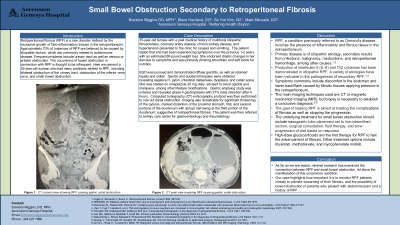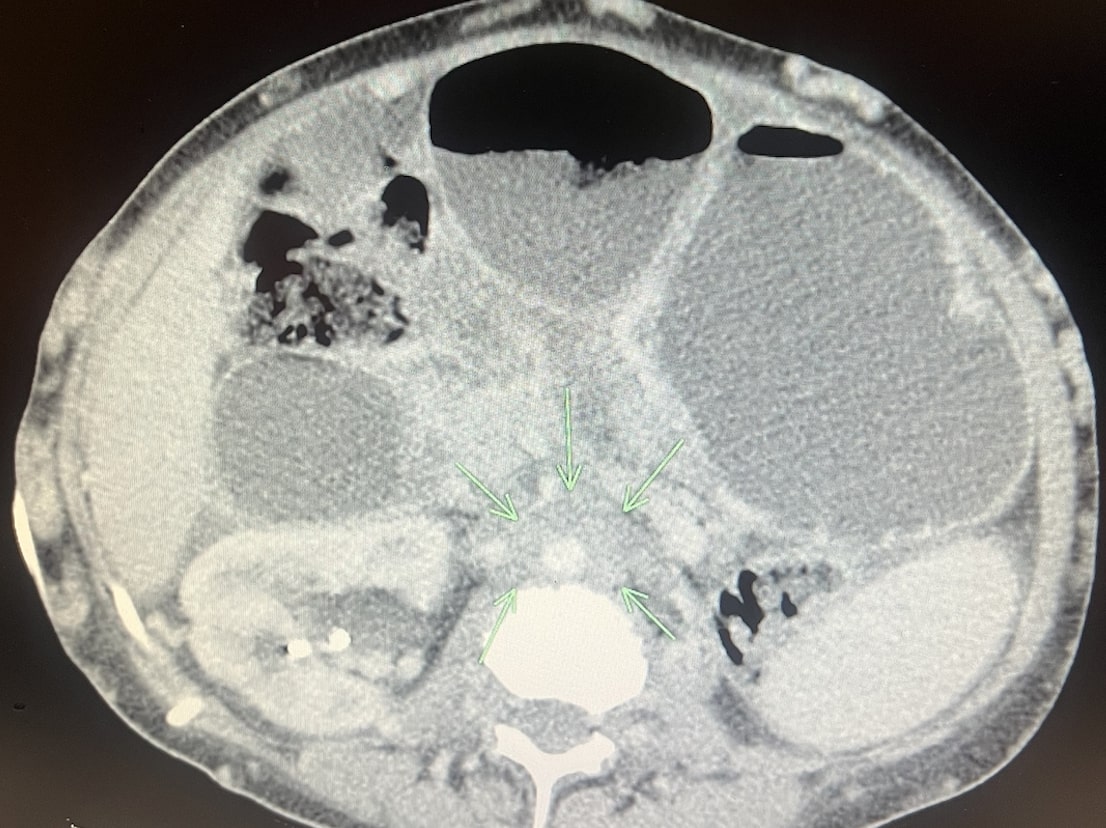Sunday Poster Session
Category: Small Intestine
P1542 - Small Bowel Obstruction Secondary to Retroperitoneal Fibrosis
Sunday, October 27, 2024
3:30 PM - 7:00 PM ET
Location: Exhibit Hall E

Has Audio

Brandon T. Wiggins, DO, MPH
Ascension Genesys Hospital
Grand Blanc, MI
Presenting Author(s)
Brandon T. Wiggins, DO, MPH1, Blace Haviland, DO2, Se Yeon Kim, DO3, Mark Minaudo, DO1
1Ascension Genesys Hospital, Grand Blanc, MI; 2Kettering Health, Dayton, OH; 3Ascension Genesys, Grand Blanc, MI
Introduction: Retroperitoneal fibrosis (RPF) is a rare condition, estimated to affect between 0.1 to 1.3 patients per 100,000 annually. The exact cause of RPF is not fully understood, but it is thought to result from prolonged inflammation leading to fibrosis within the retroperitoneum. Fibrosis can exert pressure on structures like abdominal organs leading to obstruction.
Case Description/Methods: 35 year old female with history of multifocal idiopathic fibrosclerosis presented for chronic nausea and vomiting and 60 pound weight loss. She denied any dysphagia, odynophagia, abdominal pain, constipation, diarrhea, nor GI bleeding.
EGD was then pursued and demonstrated gastritis and retained food. Gastric and duodenal biopsies were obtained and unremarkable. She was started on omeprazole once daily, advised to avoid opioids and marijuanna, and to follow an anti-reflux diet. A Gastric emptying study revealed grade 4 gastroparesis after 4 hours. CT enterography was then performed and remarkable for distention of the proximal stomach, and duodenum with abrupt narrowing at the third portion consistent with small bowel obstruction and soft tissue surrounding the abdominal aorta; both suggestive of retroperitoneal fibrosis. The patient was then referred to tertiary gastroenterology and rheumatology.
Discussion: RPF can be primary or secondary, with primary disease being idiopathic and secondary resulting from infections, malignancy, medications, autoimmune disease or retroperitoneal hemorrhage. Idiopathic disease is observed in 70% of cases. RPF is most prevalent in males and middle aged adults. Asbestos and tobacco exposure has been associated with RPF. Idiopathic RPF is considered to be on the spectrum of chronic periaortitis, a condition involving fibrosis surrounding the aorta and iliac arteries.
The most frequent presenting symptom with RPF is back or abdominal pain. Other symptoms include malaise, anorexia, weight loss, fever, nausea and vomiting.
The diagnosis of RPF involves the combination of imaging and clinic presentation, however, a definitive diagnosis can require biopsy. The primary imaging modalities utilized in the diagnosis of RPF are CT or MRI.
RPF treatment involves treating complications and preventing further fibrosis. Common complications include urinary and vascular obstruction. Less commonly RPF can lead to bowel obstruction. High-dose glucocorticoids should be initiated at time of diagnosis. Other options include rituximab, methotrexate, and mycophenolate mofetil.

Disclosures:
Brandon T. Wiggins, DO, MPH1, Blace Haviland, DO2, Se Yeon Kim, DO3, Mark Minaudo, DO1. P1542 - Small Bowel Obstruction Secondary to Retroperitoneal Fibrosis, ACG 2024 Annual Scientific Meeting Abstracts. Philadelphia, PA: American College of Gastroenterology.
1Ascension Genesys Hospital, Grand Blanc, MI; 2Kettering Health, Dayton, OH; 3Ascension Genesys, Grand Blanc, MI
Introduction: Retroperitoneal fibrosis (RPF) is a rare condition, estimated to affect between 0.1 to 1.3 patients per 100,000 annually. The exact cause of RPF is not fully understood, but it is thought to result from prolonged inflammation leading to fibrosis within the retroperitoneum. Fibrosis can exert pressure on structures like abdominal organs leading to obstruction.
Case Description/Methods: 35 year old female with history of multifocal idiopathic fibrosclerosis presented for chronic nausea and vomiting and 60 pound weight loss. She denied any dysphagia, odynophagia, abdominal pain, constipation, diarrhea, nor GI bleeding.
EGD was then pursued and demonstrated gastritis and retained food. Gastric and duodenal biopsies were obtained and unremarkable. She was started on omeprazole once daily, advised to avoid opioids and marijuanna, and to follow an anti-reflux diet. A Gastric emptying study revealed grade 4 gastroparesis after 4 hours. CT enterography was then performed and remarkable for distention of the proximal stomach, and duodenum with abrupt narrowing at the third portion consistent with small bowel obstruction and soft tissue surrounding the abdominal aorta; both suggestive of retroperitoneal fibrosis. The patient was then referred to tertiary gastroenterology and rheumatology.
Discussion: RPF can be primary or secondary, with primary disease being idiopathic and secondary resulting from infections, malignancy, medications, autoimmune disease or retroperitoneal hemorrhage. Idiopathic disease is observed in 70% of cases. RPF is most prevalent in males and middle aged adults. Asbestos and tobacco exposure has been associated with RPF. Idiopathic RPF is considered to be on the spectrum of chronic periaortitis, a condition involving fibrosis surrounding the aorta and iliac arteries.
The most frequent presenting symptom with RPF is back or abdominal pain. Other symptoms include malaise, anorexia, weight loss, fever, nausea and vomiting.
The diagnosis of RPF involves the combination of imaging and clinic presentation, however, a definitive diagnosis can require biopsy. The primary imaging modalities utilized in the diagnosis of RPF are CT or MRI.
RPF treatment involves treating complications and preventing further fibrosis. Common complications include urinary and vascular obstruction. Less commonly RPF can lead to bowel obstruction. High-dose glucocorticoids should be initiated at time of diagnosis. Other options include rituximab, methotrexate, and mycophenolate mofetil.

Figure: Coronal View of Computed Tomography Demonstrating Small Bowel Obstruction Secondary to Retroperitoneal Fibrosis
Disclosures:
Brandon Wiggins indicated no relevant financial relationships.
Blace Haviland indicated no relevant financial relationships.
Se Yeon Kim indicated no relevant financial relationships.
Mark Minaudo indicated no relevant financial relationships.
Brandon T. Wiggins, DO, MPH1, Blace Haviland, DO2, Se Yeon Kim, DO3, Mark Minaudo, DO1. P1542 - Small Bowel Obstruction Secondary to Retroperitoneal Fibrosis, ACG 2024 Annual Scientific Meeting Abstracts. Philadelphia, PA: American College of Gastroenterology.
